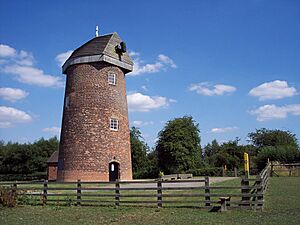Hough Windmill facts for kids
Hough Windmill is a tall, old windmill located in Swannington, Leicestershire, England. It was built a long time ago, in the late 1700s, right on the edge of the village of Thringstone. This windmill was very important for the people who lived there, especially those working in the coal mines.
Around the mill, you can still see signs of old, shallow coal mines. Maps from the past show many paths and tracks. These were used by miners walking between the different mining spots. Today, the windmill and the land around it are looked after by the Swannington Heritage Trust.
Contents
History of Hough Windmill
Earlier Windmills in the Area
Before the current Hough Windmill, there were at least five other windmills built on the high ground north of Swannington. Three local families, the Griffins, Chesters, and Kerbys, operated these mills.
The very first mills were called post mills. These were simpler and cheaper, but not as strong. The whole mill building had to be turned to face the wind. Over time, these early mills were destroyed by fires, storms, or just fell apart. One even collapsed in the early 1800s, sadly killing its owner. The parts of that mill were later sold in 1895.
Building the Present Mill
The Hough Windmill you see today was built by John Griffin. He bought the land in 1804 to replace an older post mill nearby. James Kerby was the first person to operate the new mill, paying £30 a year to rent it.
In 1877, the mill was sold to John Hough for £1,175. The Kerby family continued to run it for a while. Later, Walter Chester became the last person to operate the mill for business. The mill stopped working in the early 1900s because newer technology made windmills less useful.
Saving the Mill
By the 1980s, the mill was in ruins. The local council bought it and then sold it to the Swannington Heritage Trust in 1994. The Trust worked hard to fix up the mill. They received a grant of £70,883 from the Heritage Lottery Fund to help with the repairs.
The restored mill was officially opened on March 26, 2000, by Mr. David Taylor, who was a Member of Parliament. In its first year, the mill attracted 1,600 visitors!
Inside the mill, there is an old poster. It advertises the sale of another mill in the area. This shows how important mills were to the local communities.
Nature and Mining History Nearby
Gorse Field and Califat Spinney
The Swannington Heritage Trust also owns a 6-acre field next to the mill, called the Gorse Field. This land used to be a shared common area that was not farmed. It has signs of hundreds of "bell pits." These are small, old holes where people dug for coal as far back as 1204! The Trust is now turning this field into a nature reserve.
A replica of a "ginn engine" has been placed in the Gorse Field. This special engine, funded by the National Forest company, was used to pull things up from mines using horses.
Right next to the Gorse Field is Califat Spinney. This area has the remains of two engine houses from a coal mine that operated from 1855 to 1873.
One of the mine shafts was called the Alabama shaft. It was common back then to name shafts after important events. The CSS Alabama was a ship that sank in 1864.
Coal from the Califat mine was carried by a horse-drawn tramway. This tramway took the coal to the bottom of the Swannington Incline. There, a winding engine pulled the coal trucks up the slope. From the top, the coal continued its journey along the Leicester and Swannington Railway.
Sadly, in 1863, water from an old, unused mine flooded the Califat mine. The mine filled with water in just 11 minutes, and three miners lost their lives.


